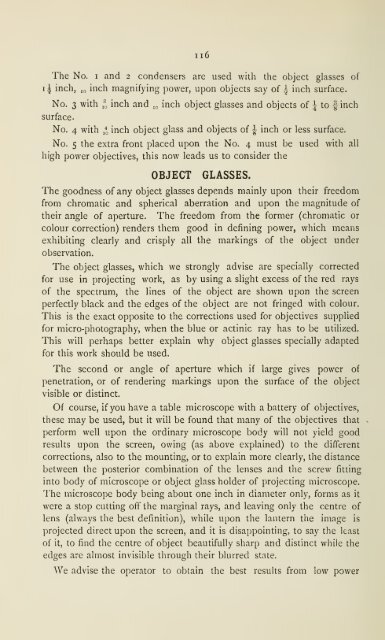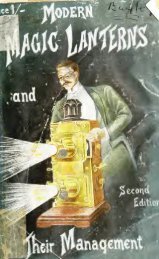The Art of projection and complete magic lantern ... - Yesterday Image
The Art of projection and complete magic lantern ... - Yesterday Image
The Art of projection and complete magic lantern ... - Yesterday Image
- No tags were found...
Create successful ePaper yourself
Turn your PDF publications into a flip-book with our unique Google optimized e-Paper software.
ii6<strong>The</strong> No. I <strong>and</strong> 2 condensers are used with the object glasses <strong>of</strong>1 1 inch, „ inch magnifying power, upon objects say <strong>of</strong> | inch surface.No. 3 with ,", inch <strong>and</strong> ,„ inch object glasses <strong>and</strong> objects <strong>of</strong> ^ to ^^-inchsurface.No. 4 with jiinch object glass <strong>and</strong> objects <strong>of</strong> |- inch or less surface.No. 5 the extra front placed upon the No. 4 must be used with allhigh power objectives, this now leads us to consider theOBJECTGLASSES.<strong>The</strong> goodness <strong>of</strong> any object glasses depends mainly upon their freedomfrom chromatic <strong>and</strong> spherical aberration <strong>and</strong> upon the magnitude <strong>of</strong>their angle <strong>of</strong> aperture. <strong>The</strong> freedom from the former (chromatic orcolour correction) renders them good in defining power, which meansexhibiting clearly <strong>and</strong> crisply all the markings <strong>of</strong> the object underobservation.<strong>The</strong> object glasses, which we strongly advise are specially correctedfor use in projecting work, as by using a slight excess <strong>of</strong> the red rays<strong>of</strong> the spectrum, the lines <strong>of</strong> the object are shown upon the screenperfectly black <strong>and</strong> the edges <strong>of</strong> the object are not fringed with colour.This is the exact opposite to the corrections used for objectives suppliedfor micro-photography, when the blue or actinic ray has to be utilized.This will perhaps better explain why object glasses specially adaptedfor this work should be used.<strong>The</strong> second or angle <strong>of</strong> aperture which if large gives power <strong>of</strong>penetration, or <strong>of</strong> rendering markings upon the surface <strong>of</strong> the objectvisible or distinct.Of course, if you have a tablemicroscope with a battery <strong>of</strong> objectives,these may be used, but it will be found that many <strong>of</strong> the objectives thatperform well upon the ordinary microscope body will not yield goodresults upon the screen, owing (as above explained) to the differentcorrections, also to the mounting, or to explain more clearly, the distancebetween the posterior combination <strong>of</strong> the lenses <strong>and</strong> the screw fittinginto body <strong>of</strong> microscope or object glass holder <strong>of</strong> projecting microscope.<strong>The</strong> microscope body being about one inch in diameter only, forms as itwere a stop cutting <strong>of</strong>f the marginal rays, <strong>and</strong> leaving only the centre <strong>of</strong>lens (always the best definition), while upon the <strong>lantern</strong> the image isprojected direct upon the screen, <strong>and</strong> it is disappointing, to say the least<strong>of</strong> it, to find the centre <strong>of</strong> object beautifully sharp <strong>and</strong> distinct while theedges are almost invisible through their blurredstate.We advise the operator to obtain the best results from low power





